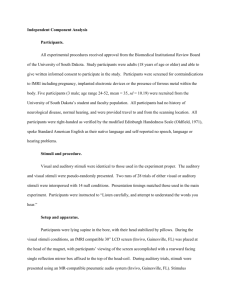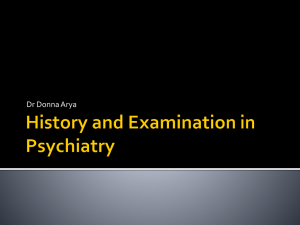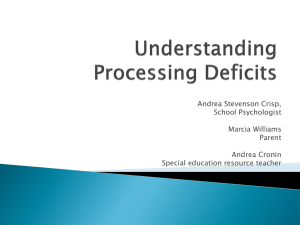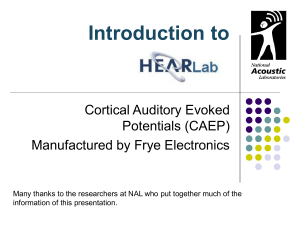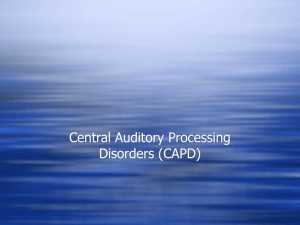Early auditory novelty processing in humans: auditory brainstem
advertisement
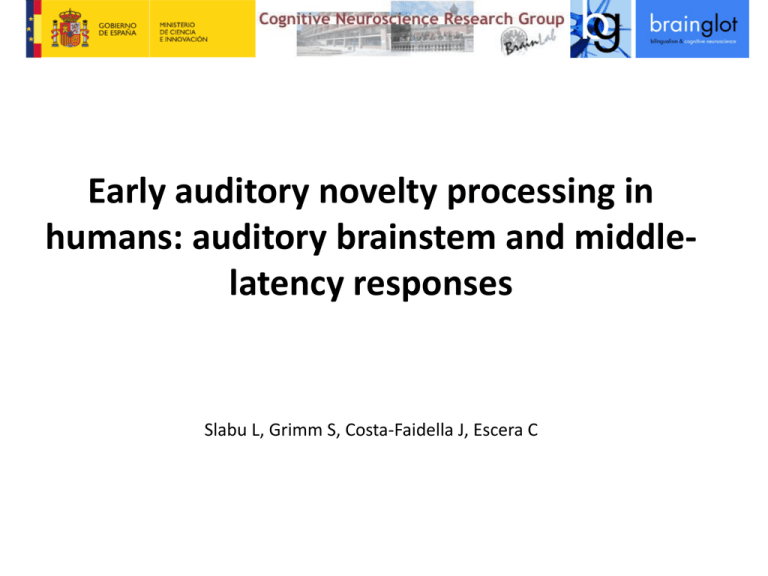
Early auditory novelty processing in humans: auditory brainstem and middlelatency responses Slabu L, Grimm S, Costa-Faidella J, Escera C Overview • Auditory Brainstem Response (ABR), Middle Latency Response (MLR) - novelty detection in animal and human studies; • Experiment; • Results and conclusions. Deviance detection in audition The marker of auditory deviance detection in the ERP is the Mismatch Negativity (MMN) elicited with the oddball paradigm. Deviance detection can be regarded as a new-information filter (Sinkkonen, 1999) that guides attention. Deviance detection gives indication to the auditory system to update the internal model about the outside world (Winkler, 2007) In animal studies … A few animal studies reported a MMN like-response in 20-30 ms post-deviant: • the primary auditory cortex of the cat (Ulanovsky et al., 2003), • the thalamus of mouse (Anderson et al., 2009), and • the inferior colliculi of barn owl (Reches and Gutfreund, 2008) and rat (PérezGonzález et al., 2005; Malmierca et al., 2009). Medial geniculate bodies Inferior colliculi Auditory cortex • The MMN recorded from the human scalp might be preceded or even initiated by earlier novelty-related activity? • The detection of novel sounds in humans might involve different levels of the auditory system’s hierarchy? In human studies … • bilateral temporal , frontal, parietal sources, hippocampus • Müller et al. (2001) showed that the earlier components of MLR exhibit amplitude suppression to a repeated sound in a paired-click paradigm. • Sonnadara and colleagues (2006) observed an enhancement of the Na component elicited by location deviant stimuli compared to standard stimuli in an oddball paradigm with stimuli consisting of brief noise bursts. In lack of a proper control, this study can be interpreted as a different state of refractoriness of location-specific neurons responding to the two types of sounds within the oddball sequence. Auditory Brainstem and Middle Latency Evoked Potentials V (7-8ms) Lateral lemniscus, Inferior colliculi Na (18 ms) midbrain, thalamus, or primary auditory cortex (PAC) Pa (30 ms) PAC Nb (40 ms) secondary auditory cordex Aim of the study •investigating the detection of frequency deviants in early stages of human auditory processing; •applying a design that controls for physical stimulus differences and for refractoriness; •adapting the paradigm to measure responses as early as the brainstem response. Goal: to investigate the effect of auditory frequency deviance detection in the time range of ABR and MLR responses using an oddball paradigm the corresponding control conditions. Experiment Participants: 18 paid volunteers (18-29 years, 15 female, 3 left handed) Stimuli and procedure: Right ear - 40 ms broadband noise bandpass filter ranging from 500 to 3000 Hz in steps of 500 Hz of (termed f1, f2, f3, f4, and f5), 80 dB SPL; Left ear - masked with white noise 60 dB SPL; SOA = 96 ms. Electrodes: Cz, with left ear lobe reference and forehead as ground Online band-pass filter: 0.05 to 1500 Hz Sampling rate: 20000 Hz, gain: 5000. Experimental design 20% deviant = 4000 stimuli Different physical stimuli Different probability Different with regard to regularity Different probability Different with regard to regularity Different with regard to regularity Analysis •Off-line filtered ABR: 100-1500 Hz. Artifacts exceeding 35 μV were rejected. MLR: 15-250 Hz. Artifacts exceeding 80 µV were rejected. •Epochs of 86 ms including a 50 ms prestimulus baseline were averaged separately for the deviant, standard and control stimuli. •The data were analyzed by means of repeated-measures analyses of variance (ANOVA) on the mean amplitudes of the V, and Na, Pa, Nb waveforms separately, including the factors Frequency (f1, f2) and Stimulus Type (deviant, standard, control). Post-hoc pairwise differences between single levels of Stimulus Type were tested applying repeated measures contrasts. Results ABR MLR Grand-average ABR (A) and MLR (B) of 18 subjects for the control stimuli (the f1, f2, f3, f4, and f5 broadband filtered noise). ABR f1 (500-1000 Hz) f2 (1000-1500 Hz) Grand-average auditory evoked potentials of 18 subjects for the frequencies f1 and f2. The ABR for the standard stimuli that preceded the deviant stimuli (blue) and the control stimuli (black) compared to the deviant stimuli (red). MLR f1 (500-1000 Hz) f2 (1000-1500 Hz) Grand-average auditory evoked potentials of 18 subjects for the frequencies f1 and f2. The MLR for the standard stimuli that preceded the deviant stimuli (blue) and the control stimuli (black) compared to the deviant stimuli (red). Results ABR: no significant differences (stimulus repetition rate, the frequency contrast between standard and deviant stimuli, the probability of the oddball stimulus occurring, Malmierca et al., 2009); MLR: an effect of Stimulus Type was observed for the time window of the Pa component (F(2,34) = 4.792, p = 0.016, with Bonferroni correction) which was absent for the other components. Post-hoc repeated measures contrasts confirmed differences between deviant and control ERPs (F(1,17) = 7.297, p = 0.015) and between deviant and standard ERPs (F(1,17 ) = 5.313, p = 0.034) in the Pa time window. Conclusions •Our data suggest that occasional changes in auditory frequency information are processed in areas of primary auditory cortex •In agreement with previous animal studies reporting novelty detection on multiple stages along the auditory pathway; our results confirm the multi-stage hypothesis of human auditory novelty detection. •More generally, the results support the notion that novelty detection is a basic property of the functional organization of the auditory system that acts at different hierarchical levels along the auditory pathway’s hierarchy. Further plans … brainstem!!! Thank you for your attention.
